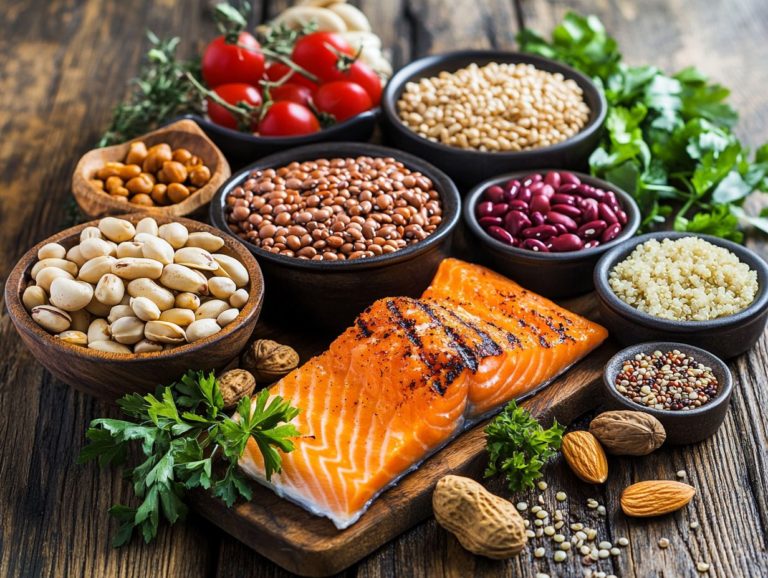Understanding Food Labels: What to Look For
Navigating the realm of food labels may feel like a daunting task, yet mastering their intricacies is crucial for making informed dietary choices.
This article carefully breaks down the essential elements of food labels, encompassing everything from Nutrition Facts and ingredient lists to serving sizes. It also delves into how to interpret nutrient information, uncover hidden ingredients, and decode marketing terms that can often lead you astray.
By the end, you’ll feel ready and confident to make healthier choices!
Contents
- Key Takeaways:
- Key Components of Food Labels
- Understanding Serving Sizes
- Interpreting Nutrient Information
- Decoding Food Claims and Marketing Terms
- Frequently Asked Questions
- What should I look for when reading food labels?
- What do the different sections on a food label mean?
- What are the most important nutrients to pay attention to on a food label?
- How can I determine if a food product is healthy based on the label?
- What are some common mistakes people make when reading food labels?
- Why is it important to understand food labels?
Key Takeaways:

- Check the Nutrition Facts and Ingredients List on food labels to make informed decisions about what you are consuming.
- Understanding serving sizes can help you accurately assess the nutritional value of a product and control your portions.
- Beware of misleading claims and marketing terms on food labels – always read the fine print and look for hidden ingredients.
Why are Food Labels Important?
Food labels are essential for you in understanding the nutritional content of the products you consume. By offering vital details such as calorie counts, serving sizes, and ingredient lists, these labels empower you to make healthier choices.
Grasping the information on these labels not only helps you track your nutrition but also enhances public health by promoting informed food selections. Regulatory standards set by organizations like the U.S. Food and Drug Administration (FDA) ensure that you receive accurate and reliable nutrition information, emphasizing the importance of food labels in your daily decision-making.
These standards outline specific guidelines regarding health claims, such as “low fat” or “high fiber,” which can significantly impact your shopping behavior. When you’re presented with clear, evidence-based information, you’re more inclined to choose products that align with your health objectives.
Organizations like the FDA diligently monitor and enforce these regulations, creating a real difference in dietary habits across the nation. By fostering informed choices and healthier eating through transparent labeling, they play a crucial role in enhancing public well-being and addressing widespread issues like obesity and chronic diseases.
Key Components of Food Labels
Key components of food labels consist of crucial elements such as the Nutrition Facts, serving size, and ingredient list, all of which offer valuable insights into a product’s nutritional profile. These components empower you to grasp the daily value of various nutrients, enabling you to make informed decisions about your food choices.
The clear presentation of food allergens and specific nutrient content claims allows you to easily identify healthier options and align them with your dietary needs. By knowing exactly what to look for on food packaging, you can significantly enhance your overall health and well-being.
Nutrition Facts
The Nutrition Facts label serves as an essential guide on food packaging, offering detailed insights into calorie count, sugar levels, saturated and trans fats, sodium content, and fiber in each serving. This section is crucial for you to evaluate the healthfulness of your food choices and pinpoint important nutrients like potassium and vitamin D, which are vital for your overall well-being.
By understanding this information, you can make informed decisions that align with your dietary objectives, whether you re looking to cut back on sugar or boost your fiber intake. For example, choosing products with lower added sugars can significantly lower your risk of obesity and diabetes, while selecting whole grains packed with fiber can enhance your digestion.
Recognizing the importance of essential vitamins can also steer you toward fortified foods, ultimately enriching your nutritional profile. This awareness empowers you and fosters healthier eating habits that contribute to your long-term wellness.
Ingredients List

The ingredients list on food labels offers a comprehensive breakdown of what goes into a product, empowering you to identify processed foods, spot food allergens, and check health claims tied to the ingredients. This clarity is crucial for making wise food choices, especially if you have specific dietary needs or preferences. Whether you’re looking for sugar alternatives or avoiding allergens, understanding the ingredients is key.
By examining the ingredients list, you can make choices that align with your health goals. Knowing about common additives like preservatives and artificial colorings helps you avoid unwanted chemicals. It’s also crucial to be aware of sugar alternatives, such as high-fructose corn syrup (a sweetener made from corn that can be more harmful than regular sugar) or aspartame, if you’re monitoring your sugar intake.
Grasping these components is essential for managing allergies or sensitivity and for making choices that enhance your overall well-being. This way, every bite you take supports your dietary aspirations, ensuring that what you consume truly aligns with your health journey.
Understanding Serving Sizes
Let s dive into understanding serving sizes! They are essential for interpreting nutrition information accurately and making informed choices about your food consumption. Serving sizes enable you to assess the calorie count and daily value of the nutrients you consume, significantly impacting your dietary habits.
Familiarizing yourself with recommended serving sizes helps you manage your intake of key nutrients and avoid overconsumption. This awareness is especially important in today’s landscape, where processed foods dominate and often mislead with portion sizes.
How to Determine Serving Size
Determining the right serving size becomes easy when you refer to food packaging, which clearly indicates serving sizes and provides valuable guidance. By consulting the nutrition facts and understanding the context of serving sizes, you can make better food choices, promoting nutrition education and healthier eating habits.
Always check the serving size on nutrition labels, as it often differs from what you might typically consume. This discrepancy can lead to unintended overconsumption of calories and other nutrients. Learning to compare these values against everyday measurements like cups or ounces empowers you to regulate your portions more effectively. Participating in workshops and informational sessions on reading packaging can further bolster your understanding, fostering a more health-conscious community.
Incorporating this knowledge into your daily life will not only enhance your well-being but also help create a culture of better eating habits.
Interpreting Nutrient Information
Interpreting nutrient information accurately is vital for understanding how different foods contribute to your daily nutrient needs and overall well-being. Familiarizing yourself with nutrient content claims and daily values helps evaluate health risks associated with high sugar levels or low dietary fiber in your diet.
This understanding is key to making informed choices that align with your dietary guidelines and health goals.
Recommended Daily Values

Recommended Daily Values serve as essential benchmarks that guide you in understanding the intake levels of various nutrients vital for maintaining optimal health. By grasping these values, you can evaluate your food choices against d dietary guidelines and pinpoint any potential health implications related to nutrient deficiencies or excesses.
These guidelines come from extensive research, incorporating scientific studies and expert consensus. They adapt as new evidence about nutrition emerges. For example, key nutrients like calcium, which plays a crucial role in bone health, have a recommended intake of 1,000 mg for most adults. Similarly, dietary fiber, essential for digestive health, is suggested at 25 grams per day for women and 38 grams for men.
By referring to these Recommended Daily Values, you empower yourself to make informed choices while grocery shopping. This ensures that you incorporate nutrient-rich foods that align with your health goals, ultimately enhancing your overall well-being.
Identifying Hidden Ingredients
Identifying the hidden ingredients in food products is essential if you want to steer clear of allergens or unhealthy additives that often plague processed foods. By closely examining labels for health claims and unfamiliar ingredient names, you can take charge of what you put into your body!
This proactive approach cultivates a greater awareness of your dietary needs and equips you with the tools to understand terms that may be deliberately obscured to mislead shoppers. Recognizing ingredients like gluten, nuts, or dairy is crucial after all, even trace amounts can trigger serious reactions.
Spotting misleading health claims, such as “natural” or “low-fat”, gives you the power to dig deeper and question the actual nutritional value of a product. Employing these strategies enables you to make healthier selections while significantly reducing potential health risks associated with poor food choices.
Decoding Food Claims and Marketing Terms
Decoding food claims and marketing terms is essential for consumers aiming to grasp the true healthfulness of processed foods. Many products flaunt health claims or nutrient content assertions, which are claims about the nutrients in the product, that can be quite misleading.
It’s crucial to scrutinize labels meticulously and rely on consumer guidance to interpret these messages accurately. Your awareness can empower you to make informed choices about what you eat.
Common Misleading Claims
Common misleading claims on food labels can certainly create confusion as you strive to meet specific dietary needs and health goals.
For instance, products that proudly display the label ‘whole grain’ often contain only a scant amount of whole grains while largely consisting of refined flours, leading you to believe you re making healthier choices. Similarly, the term ‘organic’ can be misleading when products boast a mere fraction of organic ingredients. This manipulation underscores the importance of carefully reading nutritional labels and fully comprehending ingredient lists.
To navigate these marketing intricacies, you can greatly benefit from proper nutritional education. Utilizing resources like dietary guidelines and reputable health websites can empower your food choices and help you make informed decisions in the grocery aisle.
Frequently Asked Questions

What should I look for when reading food labels?
When reading food labels, it’s important to look for the serving size, the number of servings per container, and the nutritional information for each serving. For a deeper understanding, consider what you need to know about nutrition labels. You should also pay attention to the ingredients list and any specific allergens that may be listed.
What do the different sections on a food label mean?
The first section shows the serving size and servings per container. The second section details calories, fat, cholesterol, sodium, carbohydrates, and protein.
The last section is the ingredient list. This list shows all components of the food product in order by weight.
What are the most important nutrients to pay attention to on a food label?
Focus on calories, fat, sodium, and added sugars. These key factors are vital for maintaining a healthy diet!
How can I determine if a food product is healthy based on the label?
Check for items that are low in calories, fat, and sodium. Look for products rich in essential nutrients like vitamins, minerals, and fiber.
Avoid products high in added sugars or unhealthy ingredients like trans fats!
What are some common mistakes people make when reading food labels?
A common mistake is focusing only on calorie counts without considering serving sizes. Pay attention to the ingredients list instead of just relying on the front label claims.
Many people overlook the amount of added sugars, which can greatly affect health.
Why is it important to understand food labels?
Understanding food labels is crucial for making informed and healthy food choices. It helps you know exactly what you’re consuming and make choices that fit your dietary needs.
This knowledge also helps identify potential allergens or harmful ingredients in a product!





